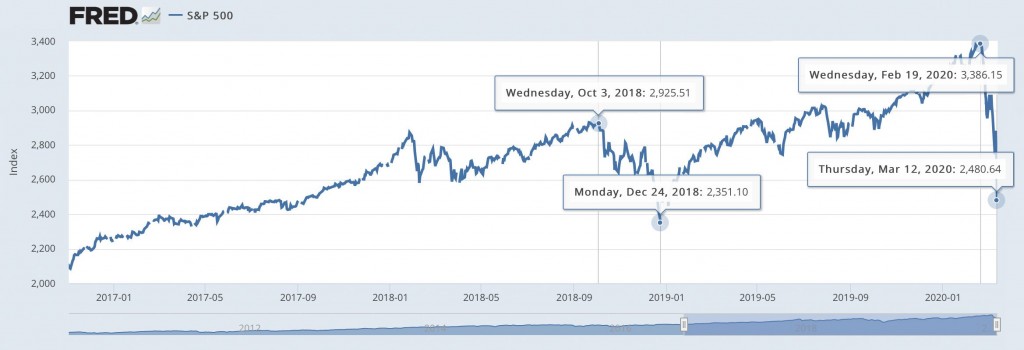CERF Blog
Written by Matthew Fienup & Dan Hamilton
Although we will be releasing a full U.S. economic forecast publication in just two weeks, the CERF team wants to take a few moments to share some thoughts and observations. We provide this to the community and our clients so they are abreast of CERF’s thoughts on recent economic developments.
Stock prices
As market-watchers, (like you) we are suffering from a serious case of whiplash. This past week saw five consecutive trading sessions in which the S&P 500 moved at least 4.9 percent between the opening and closing bells. Most dizzying of all, the S&P dropped 9.5 percent on Thursday and then added back 9.3 percent on Friday. These represent the biggest single-day loss since Black Monday in 1987 and the biggest single-day gain since the Financial Crisis.
This latest round of volatility reminds us of the end of 2018. Between October 3 and December 24 of that year, the S&P declined by 19.6 percent. December 24 marked a stunning turnaround, which led to a sustained increase of more than 44 percent.
The cause of the late-2018 market turmoil is important to keep in mind as you try to make sense of the current volatility. Very importantly, Federal Reserve policy is as much to blame for market bedlam as a viral pandemic.
The dramatic rise in stock prices since 2016 has been driven by the Fed’s policy of ultra-low interest rates. The lack of a real positive return on safe investments has driven investors into stocks, in search of yield. This was the Fed’s explicit intention. The announcement by the Fed on October 3, 2018 that ultra-low interest rates were coming to an end drove nearly 20 percent of all investment dollars out of stocks and into safer and suddenly more-attractive assets. The announcement of a policy reversal, that ultra-low interest rates would continue, drove those same investment dollars (and trillions more) back into stocks.
Does that mean we can characterize the current stock market level as a bubble? We hesitate to call the run up to the February 19 stock market high a Fed-induced asset bubble, but it was at least a bubblette. Even following the 20 percent sell-off of the past week, the S&P’s close on March 12, the recent low, was still well above the December 24, 2018 close.
All of this leads us to believe that the floor of a true market correction is probably 10 to 15 percent lower than that December 24, 2018 close – or an additional 24 percent lower than the recent bear market low. Fifteen percent below the December 24 close of 2351 would put the index right around the 2,000 level. This may shock some of our readers, but we regard this as a realistic view of the perverse impacts that monetary policy is having on markets.
Sure, blame the virus for the most recent stock market declines, but first blame the Federal Reserve for inflating the bubble(ette).
The growth outlook under pandemic
We do believe that the Coronavirus pandemic is having a large effect on economic growth in the U.S.
The latest Wall Street Journal consensus, which was released on March 12, anticipates economic growth of negative 0.1 percent in Q2 followed by a rapid V-shaped recovery in Q3. The consensus expects positive 1.2 percent growth in Q3 followed by positive 2.0 percent growth in Q4.
To us, this sounds optimistic.
With travel restrictions and with the sweeping cancellations of conferences, seminars, athletic events, and many more, we believe that at least a few months of economic contraction is coming. This would be in the form of negative income and consumption growth that appears likely for March and April, and that could extend into May and June as well. If these contractions last through June that would give a negative GDP growth result for the U.S. for the second quarter of 2020. Job growth would likely follow suit, possibly with less than a percentage point contraction given the low unemployment rate and the low labor force participation rate.
Considering the tremendous amount of economic activity that has already been suspended, our best guess is that economy could see an economic contraction in each of the next two quarters. We would not be surprised by a Q2 GDP growth figure as low as negative 1.0 percent followed by a small negative growth number in Q3. If this comes to pass, the U.S. economy will experience recession.
We believe that the travel, tourism, and trade industries will be the most impacted, with manufacturing impacted a bit less through disruptions to certain aspects of the supply chain. Business investment will be the most responsive component of expenditures. Our pre-corona virus forecast for these was already anemic, but these expenditures are likely contracting dramatically as this is being written.
With the uncertainty surrounding how the novel coronavirus will play out, that is as far as our lens extends at this time. If cases and deaths begin to subside within a couple of months, particularly in the U.S., the recovery could prove to be V-shaped, as the consensus now predicts. If so, this is one forecast that we will be happy to have gotten wrong.


